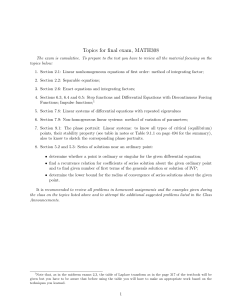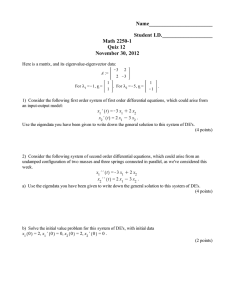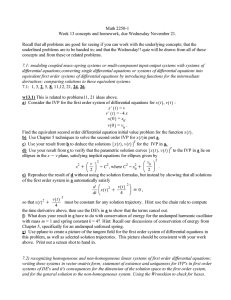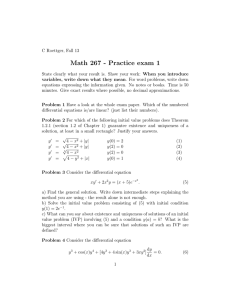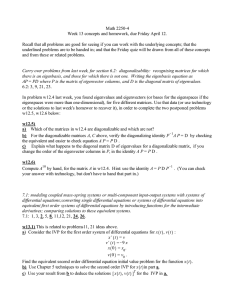Math 2250-4 Week 13 concepts and homework, due April 13.
advertisement
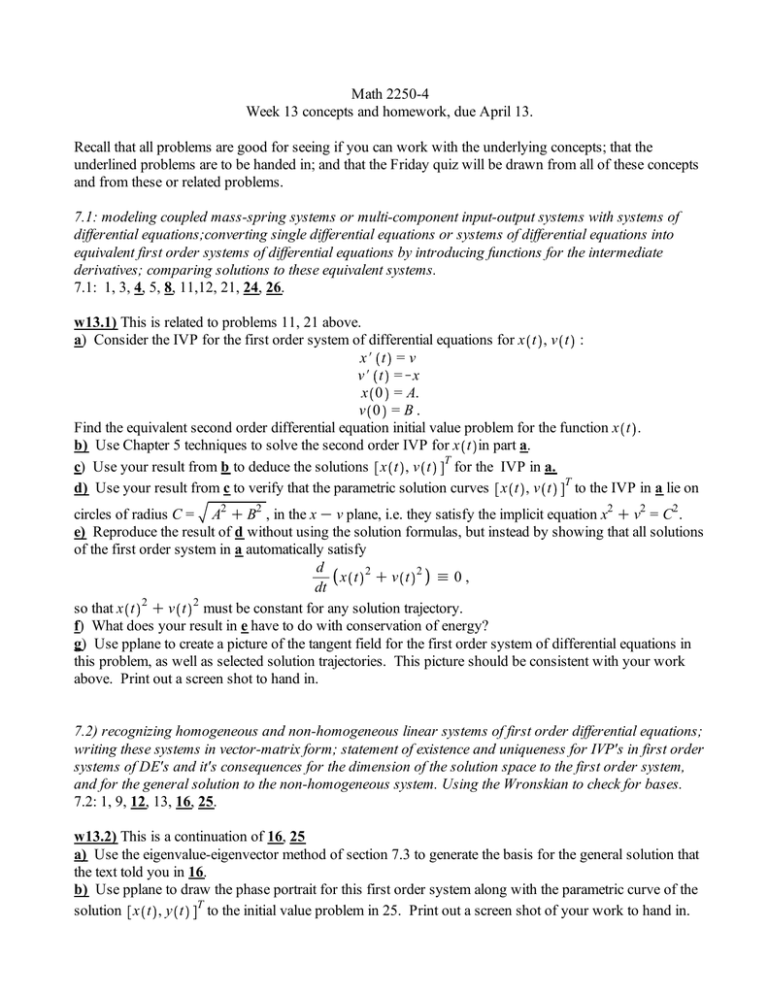
Math 2250-4 Week 13 concepts and homework, due April 13. Recall that all problems are good for seeing if you can work with the underlying concepts; that the underlined problems are to be handed in; and that the Friday quiz will be drawn from all of these concepts and from these or related problems. 7.1: modeling coupled mass-spring systems or multi-component input-output systems with systems of differential equations;converting single differential equations or systems of differential equations into equivalent first order systems of differential equations by introducing functions for the intermediate derivatives; comparing solutions to these equivalent systems. 7.1: 1, 3, 4, 5, 8, 11,12, 21, 24, 26. w13.1) This is related to problems 11, 21 above. a) Consider the IVP for the first order system of differential equations for x t , v t : x# t = v v# t =Kx x 0 = A. v 0 =B. Find the equivalent second order differential equation initial value problem for the function x t . b) Use Chapter 5 techniques to solve the second order IVP for x t in part a. c) Use your result from b to deduce the solutions x t , v t T for the IVP in a. d) Use your result from c to verify that the parametric solution curves x t , v t T to the IVP in a lie on circles of radius C = A2 C B2 , in the x K v plane, i.e. they satisfy the implicit equation x2 C v2 = C2 . e) Reproduce the result of d without using the solution formulas, but instead by showing that all solutions of the first order system in a automatically satisfy d x t 2Cv t 2 h 0 , dt 2 2 so that x t C v t must be constant for any solution trajectory. f) What does your result in e have to do with conservation of energy? g) Use pplane to create a picture of the tangent field for the first order system of differential equations in this problem, as well as selected solution trajectories. This picture should be consistent with your work above. Print out a screen shot to hand in. 7.2) recognizing homogeneous and non-homogeneous linear systems of first order differential equations; writing these systems in vector-matrix form; statement of existence and uniqueness for IVP's in first order systems of DE's and it's consequences for the dimension of the solution space to the first order system, and for the general solution to the non-homogeneous system. Using the Wronskian to check for bases. 7.2: 1, 9, 12, 13, 16, 25. w13.2) This is a continuation of 16, 25 a) Use the eigenvalue-eigenvector method of section 7.3 to generate the basis for the general solution that the text told you in 16. b) Use pplane to draw the phase portrait for this first order system along with the parametric curve of the solution x t , y t T to the initial value problem in 25. Print out a screen shot of your work to hand in. 7.3) the eigenvalue-eigenvector method for finding the solution space to homogeneous constant coefficient first order systems of differential equations: real and complex eigenvalues. 7.3: 3, 13, 29, 31, 34, 36. w13.3) Use the eigenvalue-eigenvector method to solve the initial value problem for the two coupled tanks discussed on pages 1 and 6 of our Friday April 6 class notes. Your solution should be consistent with the picture on page 6 of those notes. x1 # t x1 K3 2 = x2 # t 3 K2 x2 x1 0 x2 0 0 = 10 w13.4) Use the eigenvalue-eigenvector method (with complex eigenvalues) to solve the first order system initial value problem which is equivalent to the second order differential equation IVP on page 1 of Monday April 9 notes (which is a slight modification of the IVP on page 4 of Friday's notes). x# t v# t = x 0 v 0 0 1 x K10 K2 v = 4 K4


